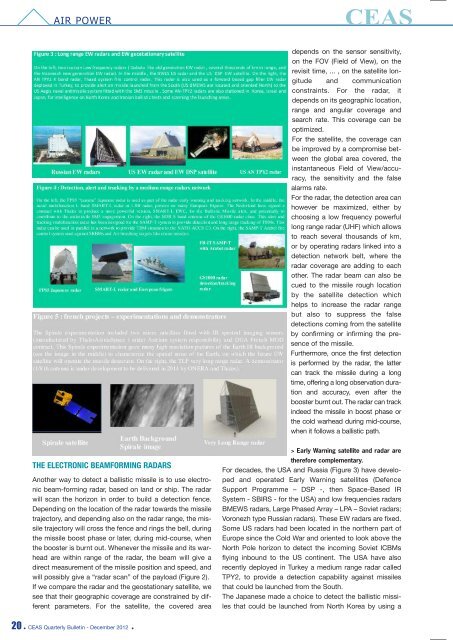Iam - CEAS. Council of European Aerospace Societies
Iam - CEAS. Council of European Aerospace Societies
Iam - CEAS. Council of European Aerospace Societies
Create successful ePaper yourself
Turn your PDF publications into a flip-book with our unique Google optimized e-Paper software.
AIR POWER<br />
THE ELECTRONIC BEAMFORMING RADARS<br />
Another way to detect a ballistic missile is to use electronic<br />
beam-forming radar, based on land or ship. The radar<br />
will scan the horizon in order to build a detection fence.<br />
Depending on the location <strong>of</strong> the radar towards the missile<br />
trajectory, and depending also on the radar range, the missile<br />
trajectory will cross the fence and rings the bell, during<br />
the missile boost phase or later, during mid-course, when<br />
the booster is burnt out. Whenever the missile and its warhead<br />
are within range <strong>of</strong> the radar, the beam will give a<br />
direct measurement <strong>of</strong> the missile position and speed, and<br />
will possibly give a “radar scan” <strong>of</strong> the payload (Figure 2).<br />
If we compare the radar and the geostationary satellite, we<br />
see that their geographic coverage are constrained by different<br />
parameters. For the satellite, the covered area<br />
20 • <strong>CEAS</strong> Quarterly Bulletin - December 2012 •<br />
depends on the sensor sensitivity,<br />
on the FOV (Field <strong>of</strong> View), on the<br />
revisit time, ... , on the satellite longitude<br />
and communication<br />
constraints. For the radar, it<br />
depends on its geographic location,<br />
range and angular coverage and<br />
search rate. This coverage can be<br />
optimized.<br />
For the satellite, the coverage can<br />
be improved by a compromise between<br />
the global area covered, the<br />
instantaneous Field <strong>of</strong> View/accuracy,<br />
the sensitivity and the false<br />
alarms rate.<br />
For the radar, the detection area can<br />
however be maximized, either by<br />
choosing a low frequency powerful<br />
long range radar (UHF) which allows<br />
to reach several thousands <strong>of</strong> km,<br />
or by operating radars linked into a<br />
detection network belt, where the<br />
radar coverage are adding to each<br />
other. The radar beam can also be<br />
cued to the missile rough location<br />
by the satellite detection which<br />
helps to increase the radar range<br />
but also to suppress the false<br />
detections coming from the satellite<br />
by confirming or infirming the presence<br />
<strong>of</strong> the missile.<br />
Furthermore, once the first detection<br />
is performed by the radar, the latter<br />
can track the missile during a long<br />
time, <strong>of</strong>fering a long observation duration<br />
and accuracy, even after the<br />
booster burnt out. The radar can track<br />
indeed the missile in boost phase or<br />
the cold warhead during mid-course,<br />
when it follows a ballistic path.<br />
> Early Warning satellite and radar are<br />
therefore complementary.<br />
For decades, the USA and Russia (Figure 3) have developed<br />
and operated Early Warning satellites (Defence<br />
Support Programme – DSP -, then Space-Based IR<br />
System - SBIRS - for the USA) and low frequencies radars<br />
BMEWS radars, Large Phased Array – LPA – Soviet radars;<br />
Voronezh type Russian radars). These EW radars are fixed.<br />
Some US radars had been located in the northern part <strong>of</strong><br />
Europe since the Cold War and oriented to look above the<br />
North Pole horizon to detect the incoming Soviet ICBMs<br />
flying inbound to the US continent. The USA have also<br />
recently deployed in Turkey a medium range radar called<br />
TPY2, to provide a detection capability against missiles<br />
that could be launched from the South.<br />
The Japanese made a choice to detect the ballistic missiles<br />
that could be launched from North Korea by using a



